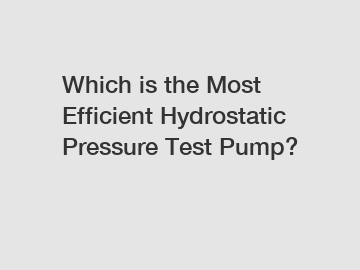Which is the Most Efficient Hydrostatic Pressure Test Pump?
Which is the Most Efficient Hydrostatic Pressure Test Pump?
Hydrostatic pressure testing is essential in various industries to ensure the durability and reliability of equipment and pipelines. To conduct this test accurately, you need a high-quality and efficient hydrostatic pressure test pump. But with so many options available in the market, how do you determine which one is the most efficient? In this article, we will explore different types of hydrostatic pressure test pumps and their efficiency factors.
1. Piston Test Pumps.

Piston test pumps are one of the most widely used types of hydrostatic pressure test pumps. They offer high pressure and flow rates, making them suitable for testing heavy-duty pipelines and equipment. These pumps work by using pistons to displace the fluid and generate pressure. They are highly efficient due to their robust construction and ability to handle high pressure.
2. Diaphragm Test Pumps.
Diaphragm test pumps operate by using a flexible diaphragm that reciprocates to create pressure. They are ideal for lower pressure testing applications, such as plumbing systems and small pipelines. Diaphragm test pumps are efficient in terms of cost and energy consumption, as they do not require complex mechanisms like piston test pumps.
3. Electric Test Pumps.
Electric test pumps are powered by electricity, either from a wall outlet or a battery. These pumps are efficient as they provide consistent pressure and flow rates. They are easy to operate and require minimal maintenance. Electric test pumps are commonly used for residential and light commercial applications.
4. Gasoline-Powered Test Pumps.
Gasoline-powered test pumps offer excellent mobility and are suitable for remote testing locations where electricity may not be readily available. These pumps are highly efficient in terms of portability but may require additional maintenance due to their internal combustion engine.
5. Efficiency Factors to Consider.
a. Pressure Range: The efficiency of a hydrostatic pressure test pump depends on its ability to deliver the required pressure accurately. Different applications require different pressure ranges, so it is crucial to choose a pump that can meet your specific needs.
b. Flow Rate: The flow rate of a pump determines how quickly it can fill the equipment or pipeline being tested. A higher flow rate can reduce the overall testing time, improving efficiency.
c. Durability: Opting for a durable and reliable pump is crucial to ensure long-term efficiency. Look for pumps made from high-quality materials that can withstand harsh testing conditions.
d. Ease of Use: An efficient hydrostatic pressure test pump should be easy to operate, maintain, and control. Look for pumps with user-friendly features, such as adjustable pressure regulators and clear pressure gauges.
e. Safety Features: Safety should be a top priority when conducting pressure testing. Look for pumps with built-in safety features, such as pressure relief valves, to prevent over-pressurization.
In conclusion, the most efficient hydrostatic pressure test pump depends on various factors, including the application, required pressure range, flow rate, durability, ease of use, and safety features. It is crucial to evaluate these factors carefully to choose the most suitable pump for your testing needs. If you have any further questions or require assistance in selecting the right pump, please do not hesitate to contact us.
Contact us to discuss your requirements of hydraulic gas booster, air driver water pump, pet bottle blowing compressors. Our experienced sales team can help you identify the options that best suit your needs.


